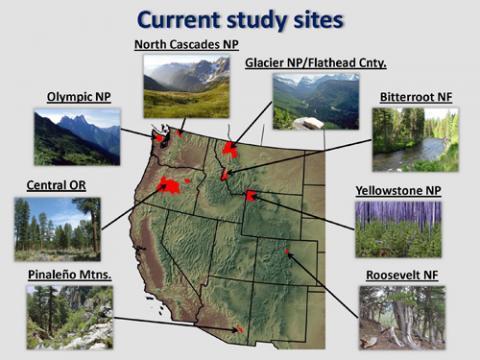Loehman, R. A., R. E. Keane, and L. M. Holsinger. 2020. Simulation Modeling of Complex Climate, Wildfire, and Vegetation Dynamics to Address Wicked Problems in Land Management. Frontiers in Forests and Global Change 3.
Keane, R. E., K. Gray, B. Davis, L. M. Holsinger, and R. Loehman. 2019. Evaluating ecological resilience across wildfire suppression levels under climate and fuel treatment scenarios using landscape simulation modelling. International Journal of Wildland Fire 28:533-549.
Keane, R. E. 2019. Applying ecosystem and landscape models in natural resource management. CRC Press, Taylor and Francis Group, Baco Raton, Florida USA.
Keane, R. E., G. J. Cary, M. D. Flannigan, R. A. Parsons, I. D. Davies, K. J. King, C. Li, R. A. Bradstock, and M. Gill. 2013. Exploring the role of fire, succession, climate, and weather on landscape dynamics using comparative modeling. Ecological Modelling 266:172-186.
Clark, J. A., R. A. Loehman, and R. E. Keane. 2017. Climate changes and wildfire alter vegetation of Yellowstone National Park, but forest cover persists. Ecosphere 8:e01636-n/a.Keane, R. E., R. A. Loehman, L. M. Holsinger, D. A. Falk, P. Higuera, S. M. Hood, and P. F. Hessburg. 2018. Use of landscape simulation modeling to quantify resilience for ecological applications. Ecosphere 9:e02414.
Keane, Robert E.; Loehman, Rachel A.; Holsinger, Lisa M. 2011. The FireBGCv2 landscape fire and succession model: a research simulation platform for exploring fire and vegetation dynamics. Gen. Tech. Rep. RMRS-GTR-255. Fort Collins, CO: U.S. Department of Agriculture, Forest Service, Rocky Mountain Research Station. 137 p.
Keane, Robert E.; Loehman, Rachel A.; Holsinger, Lisa M. 2011. The FireBGCv2 landscape fire and succession model: a research simulation platform for exploring fire and vegetation dynamics. Gen. Tech. Rep. RMRS-GTR-255. Fort Collins, CO: U.S. Department of Agriculture, Forest Service, Rocky Mountain Research Station. 137 p.
Bevins, C.D., P.L. Andrews and R.E. Keane. 1995. Forest succession modeling using the Loki software architecture. Lesnictvi-Forestry 41(4):158-162. (Refereed)
Keane, R.E., K. Ryan and S.W. Running. 1996. Simulating the effect of fire on northern Rocky Mountain landscapes using the ecological process model Fire-BGC. Tree Physiology 16:319-331. (Refereed)
Keane, R.E., K. Ryan, and S.W. Running. 1995. Simulating the effects of fire and climate change on northern Rocky Mountain landscapes using the ecological process model Fire-BGC. USDA Forest Service General Technical Report RM-262. pages 39-47.
Keane, Robert E., Penelope Morgan, Steven W. Running. 1996. Fire-BGC -- a mechanistic ecological process model for simulating fire succession on coniferous forest landscapes of the Northern Rocky Mountains. Res. Paper INT-484. Ogden, UT: U.S. Department of Agriculture Forest Service. Intermountain Research Station. 122 p.
Keane, R.E., K. Ryan and S.W. Running. 1996. Simulating the effect of fire on northern Rocky Mountain landscapes using the ecological process model Fire-BGC. Tree Physiology 16:319-331. (Refereed)
Keane, R.E., Colin Hardy, Kevin Ryan, and Mark Finney. 1997. Simulating effects of fire management on gaseous emissions from future landscapes of Glacier National Park, Montana, USA. World Resource Review 9(2):177-205 (Refereed).
Keane, R.E., K. Ryan, and Mark Finney. 1998. Simulating the Consequences of Altered Fire Regimes on a Complex Landscape in Glacier National Park, USA. In: Pruden, T.L. and L.A. Brennan (editors): Tall Timbers Fire Ecology Conference Proceedings 20: 310-324. (Refereed)
Loehman, Rachel A.; Corrow, Allissa; Keane, Robert E. 2011. Modeling climate changes and wildfire Interactions: Effects on whitebark Pine (Pinus albicaulis) and implications for restoration, Glacier National Park, Montana, USA. Pages 176-188 In: Keane, Robert E.; Tomback, Diana F.; Murray, Michael P.; and Smith, Cyndi M., eds. 2011. The future of high-elevation, five-needle white pines in Western North America: Proceedings of the High Five Symposium. 28-30 June 2010; Missoula, MT. Proceedings RMRS-P-63. Fort Collins, CO: U.S. Department of Agriculture, Forest Service, Rocky Mountain Research Station. 376 p. Online at
Keane RE, Cary GJ, Flannigan MD, Parsons RA, Davies ID, King KJ, Li C, Bradstock RA, Gill M. 2013. Exploring the role of fire, succession, climate, and weather on landscape dynamics using comparative modeling. Ecological Modelling 266(2013) 172-186. (Refereed).
Holsinger, L. R. Keane, D. Isaak, L. Elby, and M. Young. March 2014. Relative effects of climate change and wildfires on stream temperatures: a simulation modeling approach in a Rocky Mountain watershed. Climatic Change. DOI 10.1007/s10584-014-1092-5
Riggs, R. A., R. E. Keane, N. Cimon, R. Cook, L. Holsinger, J. Cook, T. DelCurto, L. S. Baggett, D. Justice, D. Powell, M. Vavra, and B. Naylor. 2015. Biomass and fire dynamics in a temperate forest-grassland mosaic: Integrating multi-species herbivory, climate, and fire with the FireBGCv2/GrazeBGC system. Ecological Modelling 296:57-78.

